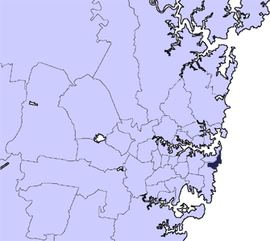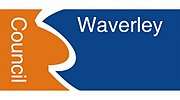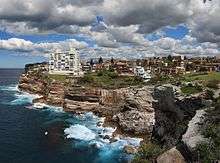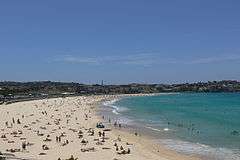Waverley Municipal Council
| Waverley Municipal Council New South Wales | |||||||||||||||
|---|---|---|---|---|---|---|---|---|---|---|---|---|---|---|---|
 Location in Metropolitan Sydney | |||||||||||||||
| Coordinates | 33°54′S 151°16′E / 33.900°S 151.267°ECoordinates: 33°54′S 151°16′E / 33.900°S 151.267°E | ||||||||||||||
| Population | 66,812 (2016 census)[1] | ||||||||||||||
| • Density | 7,400/km2 (19,200/sq mi) | ||||||||||||||
| Established | 16 June 1859 | ||||||||||||||
| Area | 9 km2 (3.5 sq mi) | ||||||||||||||
| Mayor | John Wakefield (Labor) | ||||||||||||||
| Council seat | Bondi Junction | ||||||||||||||
| Region | Metropolitan Sydney | ||||||||||||||
| State electorate(s) | |||||||||||||||
| Federal Division(s) | Wentworth | ||||||||||||||
 | |||||||||||||||
| Website | Waverley Municipal Council | ||||||||||||||
| |||||||||||||||
Waverley Municipal Council (or Waverley Council) is a Local government area (LGA) in the eastern suburbs of Sydney, in the state of New South Wales, Australia. There are four wards within Waverley LGA namely Bondi, Hunter, Lawson, and Waverley.[2]
The current Mayor of Waverley Municipal Council is Cr. John Wakefield, a member of the Labor Party.
Suburbs and localities in the local government area

Suburbs serviced by Waverley Council are:
- Bondi
- Bondi Beach
- Bondi Junction
- Bondi North
- Bronte
- Clovelly
- Dover Heights
- Queens Park
- Rose Bay (parts are located within Woollahra Council)
- Tamarama
- Vaucluse
- Waverley
These localities are also serviced by Waverley Council:
- Ben Buckler
- Bondi South
- Bronte Beach
- Charing Cross
- Diamond Bay
- Lugar Brae
- Mill Hill
- Nelson Bay
- Rose Bay North
- Tamarama Bay
Note: On 6 October 1944, the recommendation to remove the Mill Hill area (37 acres) from the Randwick LGA and include it in the Waverley LGA was proclaimed in the NSW Government Gazette. The recommendation was the result of a 1941 NSW Local Government Department Commission of Inquiry.[3]
Demographics
At the 2011 census, there were 63,487 people in the Waverley LGA, of these 49.2% were male and 50.8% were female. Aboriginal and Torres Strait Islander people made up 0.4% of the population. The median age of people in the Municipality of Waverley was 35 years. Children aged 0 – 14 years made up 15.4% of the population and people aged 65 years and over made up 12.0% of the population. Of people in the area aged 15 years and over, 37.4% were married and 10.0% were either divorced or separated.[4]
Population growth in the Municipality of Waverley between the 2001 Census and the 2006 Census was 3.31%; and in the subsequent five years to the 2011 Census, population growth was 4.57%. When compared with total population growth of Australia for the same periods, being 5.78% and 8.32% respectively, population growth in the Waverley local government area was a little over half the national average.[5] The median weekly income for residents within the Municipality of Waverley was more than 1.5 times the national average.[4][6]
The proportion of residents in Waverley LGA who stated their ancestry was Jewish was three times the New South Wales and national averages. The proportion of households where Russian is spoken at home is thirteen times the state and national averages; and of all households where Hebrew is spoken in New South Wales, one third are located in the Municipality of Waverley, and in Australia, one tenth of households where Hebrew is spoken are located in Waverley LGA. The proportion of residents who stated an affiliation with Judaism was in excess of twenty–eight times the state and national averages.[4]
| Selected historical census data for Waverley local government area | ||||||
|---|---|---|---|---|---|---|
| Census year | 2001[5] | 2006[6] | 2011[4] | 2016[1] | ||
| Population | Estimated residents on census night | 58,769 | 60,715 | 63,487 | 66,812 | |
| LGA rank in terms of size within New South Wales | 36th | |||||
| % of New South Wales population | 0.92% | |||||
| % of Australian population | 0.31% | |||||
| Estimated ATSI population on census night | 199 | 196 | 245 | 270 | ||
| % of ATSI population to residents | 0.3% | |||||
| Cultural and language diversity | ||||||
| Ancestry, top responses | English | 20.9% | ||||
| Australian | 16.1% | |||||
| Irish | 9.3% | |||||
| Scottish | 5.5% | |||||
| Jewish | 3.1% | |||||
| Language, top responses (other than English) | Russian | 3.2% | ||||
| Spanish | n/c | |||||
| Portuguese | n/r | n/r | n/r | |||
| French | n/c | n/c | ||||
| Italian | 1.5% | |||||
| Religious affiliation | ||||||
| Religious affiliation, top responses | No religion, so described | 16.9% | ||||
| Catholic | 22.9% | |||||
| Judaism | 16.1% | |||||
| Religion not stated | n/r | n/r | n/r | |||
| Anglican | 13.5% | |||||
| Median weekly incomes | ||||||
| Personal income | Median weekly personal income | A$765 | A$973 | A$1,151 | ||
| % of Australian median income | 164.2% | |||||
| Family income | Median weekly family income | A$1,446 | A$2,496 | A$2,917 | ||
| % of Australian median income | 140.8% | |||||
| Household income | Median weekly household income | A$1,928 | A$1,912 | A$2,308 | ||
| % of Australian median income | 164.6% | |||||
| Dwelling structure | ||||||
| Dwelling type | Separate house | 17.9% | ||||
| Semi-detached, terrace or townhouse | 18.7% | |||||
| Flat or apartment | 51.7% | |||||
Council
NSW Local Government Elections are held every four years on the second Saturday of September as declared by the NSW Local Government Act 1993 No. 30 Part 4, Clause 287 (1).[7][8]
Current composition and election method
Waverley Municipal Council is composed of twelve Councillors elected proportionally from the four separate wards, each electing three Councillors. All Councillors are elected for a fixed four-year term of office. The Mayor is elected by the Councillors at the first meeting of the Council. The most recent election was held on 9 September 2017, and the makeup of the Council is as follows:
| Party | Councillors | |
|---|---|---|
| Liberal Party | 5 | |
| Labor Party | 4 | |
| The Greens | 3 | |
| Total | 12 | |
The current Council, elected in 2017, in order of election by ward, is:
| Ward | Councillor | Party | Notes | |
|---|---|---|---|---|
| Bondi Ward[9] | Leon Goltsman | Liberal | ||
| Dominic Wy Kanak | Greens | Deputy Mayor | ||
| John Wakefield | Labor | Mayor | ||
| Hunter Ward[10] | Sally Betts | Liberal | ||
| Will Nemesh | Liberal | |||
| Steven Lewis | Labor | |||
| Lawson Ward[11] | Angela Burrill | Liberal | ||
| Elaine Keenan | Greens | |||
| Paula Masselos | Labor | |||
| Waverley Ward[12] | Tony Kay | Liberal | ||
| George Copeland | Greens | |||
| Marjorie O'Neill | Labor | |||
History
On 11 November 1858 a petition for the incorporation of the Municipality of Waverley was presented to the Governor of the Colony of NSW, Sir William Thomas Denison; a second petition was presented to Sir Denison on 17 May 1859. Denison approved the proclamation establishing the Municipality of Waverley on 13 June 1859, and it was subsequently published on 16 June 1859[13][14] as a fourth supplement to the New South Wales Government Gazette of 14 June 1859. The legislation that enabled the Municipality of Waverley to be established was the Municipalities Act of 1858 (22 Vic. No. 13).[15][16] On 15 June 1859, the first returning officer for the Municipality of Waverley, Charles St. Julian, Esquire of Paddington was proclaimed by Denison. Denison also stated that the first meeting of the Municipality of Waverley was to be held at midday on 14 July 1859.[17] The first Council meeting was held on 16 June 1859, but there was no permanent office for the conduct of Council duties some early meetings were held in the Charing Cross Hotel and others in the old School of Arts building in Bronte Road.
In December 1860 the Council accepted an offer from Francis O'Brien of a site for a Council Chambers, free of cost, in Bondi Road. The cost of building was to be limited to ₤500, although approximately £700 was eventually spent. The foundation stone was laid in 1861, and a first meeting of Council was held there on 21 November 1861, the first Council building erected by any municipality under the Municipalities Act of 1858. Discussions were held during the early 1900s over the need for new Council Chambers, and in 1913 a portion of the north-west corner of Waverley Park was dedicated as the site for a new building. A report of the same year stated that the original building was too small for the staff, and had poor ventilation and lighting. It was later sold for £1,600. The new building was completed by the end of 1913, and on 6 January 1914 the Council met for the first time in the new chambers.
Parts of the 1913 chambers still form the shell of the present Council Chambers, although extensive alterations in 1962, and further development in 1976 and 1977 have altered its appearance considerably. There is clear evidence - in the form of significant Aboriginal rock carvings in particular - that Aboriginal people occupied sites in the area now known as Waverley in the period before European settlement. A number of place names within Waverley Municipal Council area, most famously Bondi, have been based on words derived from Aboriginal languages of the Sydney region.[18]
A 2015 review of local government boundaries recommended that the Municipality of Waverley merge with the Woollahra and Randwick councils to form a new council with an area of 58 square kilometres (22 sq mi) and support a population of approximately 274,000.[19] Following an independent review, in May 2016 the NSW Government sought to dismiss the Council and force its amalgamation with Woollahra and Randwick councils. Woollahra Council instigated legal action claiming that there was procedural unfairness and that a KPMG report at the centre of merger proposals had been "misleading". The matter was heard before the NSW Court of Appeal who, in December 2016, unanimously dismissed Woollahra Council's appeal, finding no merit in its arguments that the proposed merger with Waverley and Randwick councils was invalid.[20] In July 2017, the Berejiklian government decided to abandon the forced merger of the Woollahra, Waverley and Randwick local government areas, along with several other proposed forced mergers.[21]
In 2017, the council banned the construction of a synagogue near Bondi Beach due to fears of Islamic terrorism. The ban was widely criticized as antisemitic and a reward to terror.[22][23]
Heritage listings
The Municipality of Waverley has a number of heritage-listed sites, including:
- Bondi, 36 Anglesea Street: Electricity Substation No. 269[24]
- Bondi, Blair Street: Bondi Ocean Outfall Sewer[25]
- Bondi, 60 Blair Street: St Anne's Catholic Church, Bondi[26]
- Bondi, Military Road: Bondi Sewer Vent[27]
- Bondi Beach, Queen Elizabeth Drive: Bondi Beach Cultural Landscape[28]
- Bondi Junction and Waverley, Paul Street: Waverley Reservoirs[29][30]
- Bronte, 470 Bronte Road: Bronte House[31]
- Bronte, St Thomas Street: Waverley Cemetery[32]
- North Bondi, Ben Buckler Gun Battery[33]
- Vaucluse, 793 Old South Head Road: South Head General Cemetery[34]
- Waverley, 240 Birrell Street: St Mary's Anglican Church, Waverley[35]
- Waverley, 11 Victoria Street: Charing Cross (homestead)[36]
- Waverley, 45 Victoria Street: Mary Immaculate Catholic Church, Waverley[37]
References
- 1 2 Australian Bureau of Statistics (27 June 2017). "Waverley (A)". 2016 Census QuickStats. Retrieved 15 January 2018.

- ↑ "Electoral Commission NSW - Waverley Council".
- ↑ DOWD, B.T (Bernard Thomas) (1959). The history of the Waverley Municipal District : published by the Council of the Municipality of Waverley (New South Wales) to commemorate its centenary of municipal government (1859-1959) - also known as The Centenary of the Municipality of Waverley,1859-1959 (PDF). Waverley, N.S.W. : Municipal Council. p. 83.
- 1 2 3 4 Australian Bureau of Statistics (31 October 2012). "Waverley (A)". 2011 Census QuickStats. Retrieved 11 November 2012.

- 1 2 Australian Bureau of Statistics (9 March 2006). "Waverley (A)". 2001 Census QuickStats. Retrieved 11 November 2012.
- 1 2 Australian Bureau of Statistics (25 October 2007). "Waverley (A)". 2006 Census QuickStats. Retrieved 11 November 2012.
- ↑ "Local Government". Electoral Commission NSW.
- ↑ "NSW Legislation - Local Government Act 1993 No 30". Government of New South Wales.
- ↑ "Waverley Council - Bondi Ward". Local Government Elections 2012. Electoral Commission of New South Wales. 15 September 2012. Retrieved 20 September 2012.
- ↑ "Waverley Council - Hunter Ward". Local Government Elections 2012. Electoral Commission of New South Wales. 15 September 2012. Retrieved 20 September 2012.
- ↑ "Waverley Council - Lawson Ward". Local Government Elections 2012. Electoral Commission of New South Wales. 15 September 2012. Retrieved 20 September 2012.
- ↑ "Waverley Council - Waverley Ward". Local Government Elections 2012. Electoral Commission of New South Wales. 15 September 2012. Retrieved 20 September 2012.
- ↑ DOWD, B.T (Bernard Thomas) (1959). The history of the Waverley Municipal District : published by the Council of the Municipality of Waverley (New South Wales) to commemorate its centenary of municipal government (1859-1959) - also known as The Centenary of the Municipality of Waverley,1859-1959 (PDF). Waverley, N.S.W. : Municipal Council. pp. IV - V and pages 50–58.
- ↑ "Proclamation of the incorporation of the district of Waverley as a Municipality". NSW Government Gazette No. 115, 16 June 1859, folios 1343-1344. 16 June 1859.
- ↑ "Municipalities Act of 1858 (22 Vic. No. 13)" (PDF).
- ↑ "Waverley Council Chambers" (PDF). Waverley Council. Retrieved 5 November 2015.
- ↑ DOWD, B.T (Bernard Thomas) (1959). The history of the Waverley Municipal District : published by the Council of the Municipality of Waverley (New South Wales) to commemorate its centenary of municipal government (1859-1959) - also known as The Centenary of the Municipality of Waverley,1859-1959 (PDF). Waverley, N.S.W. : Municipal Council. p. 59.
- ↑ https://www.creativespirits.info/australia/new-south-wales/sydney/bondi-golf-course-aboriginal-site
- ↑ "Merger proposal: Randwick City Council, Waverley Council, Woollahra Municipal Council" (PDF). Government of New South Wales. January 2016. p. 7. Retrieved 4 March 2016.
- ↑ Visentin, Lisa (22 December 2016). "Woollahra loses merger appeal, hints at High Court challenge". The Sydney Morning Herald. Retrieved 31 December 2016.
- ↑ Blumer, Clare; Chettle, Nicole (27 July 2017). "NSW council amalgamations: Mayors fight to claw back court dollars after backflip on merger". ABC News. Australia. Retrieved 27 July 2017.
- ↑ Bondi synagogue ban over terrorism risk leaves Jewish community shocked and furious, news.com.au, Joe Hildebrand, 3 August 2017
- ↑ Even in Sydney, Jews still being made to run away and hide, The Australian, Caroline Overington, 12 August 2017
- ↑ "Electricity Substation No. 269, New South Wales State Heritage Register (NSW SHR) Number H01791". New South Wales State Heritage Register. Office of Environment and Heritage. Retrieved 18 May 2018.
- ↑ "BOOS (Bondi Ocean Outfall Sewer), New South Wales State Heritage Register (NSW SHR) Number H01623". New South Wales State Heritage Register. Office of Environment and Heritage. Retrieved 18 May 2018.
- ↑ "St. Anne's Church, New South Wales State Heritage Register (NSW SHR) Number H01706". New South Wales State Heritage Register. Office of Environment and Heritage. Retrieved 18 May 2018.
- ↑ "Sewer Vent (Ben Buckler), New South Wales State Heritage Register (NSW SHR) Number H01637". New South Wales State Heritage Register. Office of Environment and Heritage. Retrieved 18 May 2018.
- ↑ "Bondi Beach Cultural Landscape, New South Wales State Heritage Register (NSW SHR) Number H01786". New South Wales State Heritage Register. Office of Environment and Heritage. Retrieved 18 May 2018.
- ↑ "Waverley Reservoir (Elevated) (WS 0136), New South Wales State Heritage Register (NSW SHR) Number H01646". New South Wales State Heritage Register. Office of Environment and Heritage. Retrieved 18 May 2018.
- ↑ "Waverley Reservoir No.1 (WS 0132), New South Wales State Heritage Register (NSW SHR) Number H01353". New South Wales State Heritage Register. Office of Environment and Heritage. Retrieved 18 May 2018.
- ↑ "Bronte House, New South Wales State Heritage Register (NSW SHR) Number H00055". New South Wales State Heritage Register. Office of Environment and Heritage. Retrieved 18 May 2018.
- ↑ "Waverley Cemetery, New South Wales State Heritage Register (NSW SHR) Number H01975". New South Wales State Heritage Register. Office of Environment and Heritage. Retrieved 18 May 2018.
- ↑ "Ben Buckler Gun Battery 1893, 9.2 Disappearing Gun, New South Wales State Heritage Register (NSW SHR) Number H01742". New South Wales State Heritage Register. Office of Environment and Heritage. Retrieved 18 May 2018.
- ↑ "South Head General Cemetery, New South Wales State Heritage Register (NSW SHR) Number H01991". New South Wales State Heritage Register. Office of Environment and Heritage. Retrieved 18 May 2018.
- ↑ "St. Mary's Anglican Church and Pipe Organ, New South Wales State Heritage Register (NSW SHR) Number H00160". New South Wales State Heritage Register. Office of Environment and Heritage. Retrieved 18 May 2018.
- ↑ "Charing Cross, New South Wales State Heritage Register (NSW SHR) Number H00449". New South Wales State Heritage Register. Office of Environment and Heritage. Retrieved 18 May 2018.
- ↑ "Mary Immaculate Group, New South Wales State Heritage Register (NSW SHR) Number H00626". New South Wales State Heritage Register. Office of Environment and Heritage. Retrieved 18 May 2018.
